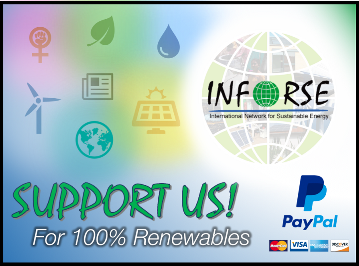|
|
|
|
|
|
|
|
|
|
|
|
|
|
|
|
|
|
|
|
|
| Follow Us: |
| Wind Energy in China: Institutional Barriers | |
| China has a huge potential to become a dynamic nation in wind energy development, if institutional barriers are reduced. To realize this expectation, vigorous policy measures at the national and regional levels need to be established and readjusted. | |
| 150,000 Small Windmills | |
| Until the late 1980s, China’s wind turbine development’s main objective was to establish capacity via domestically manufactured small-scale wind turbines. The main aim was to build a decentralized, environment-friendly energy system and to increase the quality of life for the poor in isolated rural communities. As a result, in 1996, there were 150,000 Chinese-made small wind turbines in use. China’s small wind turbines have become a mature technology with increasing export. Currently, products are being exported to 22 countries. | |
| Large Wind Turbine Import | |
| The shift of policy emphasis toward large wind turbines started in the early 1990s. Prototypes for wind turbines of 100-200 kW were tested and demonstrated from 1985 to 1995, but efforts to market them largely failed. This failure can be attributed to high-tech contents of large wind turbines, small investment, and high cost. In 1990, the wind farms’ installed capacity was 13 MW; by 1996, this number had increased to 60 MW (16 wind farms with 237 units) and, by 1997, to 160 MW. Another 71 units of 500-600kW generators will be installed in 1998. Most of the production units are imported from foreign suppliers. | |
| Future Plans and Potentials | |
| Exploitable wind resources are estimated at 250 GW. China has set up a plan to develop 1,000 MW of wind energy capacity by the year 2000. This objective will require about 10 billion Yuan (US$ 1.2 billion) of investment. Large-scale wind farms in Xinjiang, Inner Mongolia, and Guangdong Provinces are under rapid development. In Guangdong, the first domestically manufactured wind turbines (200 kW and 300 kW) have been installed and demonstrated. | |
| Investment Loans, Taxes, and Price Distortions | |
| Wind energy development in China is restrained by relatively high investment costs. Bank loans for wind energy investment have high interest rates (11.7%) and short terms (less than 5 years to pay back the loan). Taxes for imported equipment are high: import tax (12%) and VAT (17%). VAT for small hydroelectric development is at 6%. Soft credits provided by foreign governments usually contain 35% grants, but this advantage is overtaken by the taxes. In addition, VAT for electricity produced from wind is set at 17%, the same as for electricity generated by coal-based power plants, which enjoy the advantage of taking depreciation on equipment. No depreciation incentives for wind turbines are available so far. Current development of wind energy is further handicapped by low prices for wind-generated electricity. There are wide energy-price distortions in the energy market. Wind energy competes unfavorably with other conventional energy sources such as coal, because of the lack of proper energy-price mechanisms that could internalize social and environmental costs of energy production, distribution, and consumption. | |
| State-owned Companies | |
| State-owned companies are the main players in China’s wind-energy market, such as the China Fulin Windpower Development Corporation, established in ´92, and others on the regional level in Inner Mongolia, Xinjiang, and Guangdong Province, where wind energy is given high priority. Most provinces shows a growing interest in wind. | |
| Private Sector | |
| Large foreign companies started their engagement in China in the late 1980s. Lately, their involvement in China has intensified, particularly through cooperation with regional governments and the national wind energy companies. Private Chinese companies involved in the wind energy industry are rare. This is related to high risks in investment and long pay-back periods. However, some private enterprises and groups are showing strong interest in investing in wind development, but they are reluctant to take decisive action because of the lack of policy incentives. | |
| Need to Move Barriers | |
| China’s experience in wind energy development demonstrates that a lack of adequate policy framework constitutes a major barrier to cost-effective wind energy dissemination. This is due in part to an energy policy distorted in favor of conventional, i.e., fossil-fuel-based energy expansion. Many distorted policies are established due to the lack of understanding of wind-energy-related social and environmental benefits. It is important to make more efforts in human-resources development and capacity-building. The roles of education, training, and media are crucial in fostering such development in the long run. Current wind energy development in China is sustained to some extent by incentives such as soft loans and grants that are provided by multilateral and bilateral development assistance. To achieve sustainable development of wind energy, mechanisms for encouraging interest from the private sector and commercialization of domestic products should be improved. More information: Center for International Climate and Environmental Research, Oslo (CICERO), P.O. Box 1129 Blindern, N-0317 Oslo, Norway. Ph: +47 22 858783, fax: +47 22 858751, e-mail: lin.gan@cicero.uio.no. | |

| |
| Published in Sustainable Energy News |
|
|
Go back to main page of ISSUE #22, Sustainable Energy News (16 pages) (1998-09-01) |
|
| Contact | |
| |
INFORSE Secretariat Klosterport 4F, 1. floor DK-8000 Aarhus C Denmark Phone: +45 86 22 70 00 Twitter: INFORSE_org Facebook: INFORSE Web: inforse.org E-mail: ove@inforse.org |
